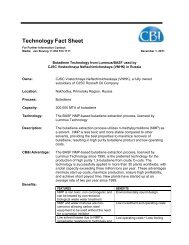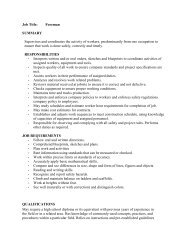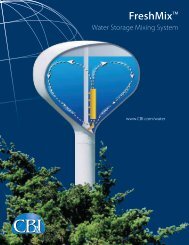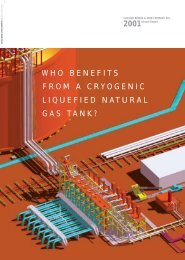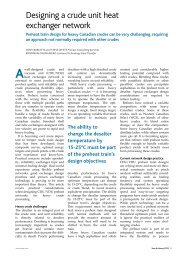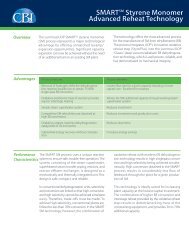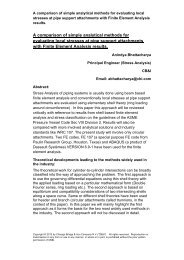Coker design achieves cycle times, throughput needs at ... - CB&I
Coker design achieves cycle times, throughput needs at ... - CB&I
Coker design achieves cycle times, throughput needs at ... - CB&I
Create successful ePaper yourself
Turn your PDF publications into a flip-book with our unique Google optimized e-Paper software.
P r o c e s s i n g<strong>Coker</strong> <strong>design</strong> <strong>achieves</strong> <strong>cycle</strong> <strong>times</strong>,<strong>throughput</strong> <strong>needs</strong> <strong>at</strong> Kansas refineryDon MulraneyArt StefaniCB&IHoustonCoby StewartFrontier El Dorado RefiningEl Dorado, Kan.RefiningOver the last few years, FrontierRefining’s plant in El Dorado, Kan., hasundergone a major refinery reconfigur<strong>at</strong>ionto facilit<strong>at</strong>e processing a gre<strong>at</strong>erproportion of very heavy crudes. TheThis view shows the completed Frontier El Dorado coker alongside an existingcoking structure (Fig. 1).project added a new vacuum unit andrevamped several existing units for processingthe heavier crude oil feed.These modific<strong>at</strong>ions produced significantconstraints on the coker unit, dueto the lack of sufficient coke-drum volume.Frontier evalu<strong>at</strong>ed running shorterdrum <strong>cycle</strong>s, but review of the drum’svapor velocity indic<strong>at</strong>ed severe foamingand carryover would likely result.In addition, coke-drum reliabilitywas decreasing because of frequentdrum cracks. Frontier evalu<strong>at</strong>ed severaloptions for repairingthe existingdrums, but mostwere deemedunacceptable dueto the extendedunit downtime th<strong>at</strong>would have beenrequired to completethe work.CB&I had beenadvising Frontieron these drumevalu<strong>at</strong>ions, includingthe anticip<strong>at</strong>edcoke make increase.Frontier and CB&Iconcluded the existingcoke drumsshould be replacedwith larger drums.Scopeof projectIn 2006, CB&Iwas contractedto evalu<strong>at</strong>e theexisting coker todetermine its suitabilityto processthe new feed. Withthe exception of the coker feed prehe<strong>at</strong>train, blowdown steam condensing, andthe larger coke drums, the existing unitwas capable of handling the new feedcomposition.CB&I and Frontier set the cokedrum’s size based upon the new feedand Frontier’s expected future expansioncapacity: 26 ft diameter and 70ft. It was determined th<strong>at</strong> the existingcoke drum’s piping and valving wouldbe acceptable for the new capacity,which set the scope of the new cokedrum’s structure as follows:• Two new vertical pl<strong>at</strong>e cokedrums.• New found<strong>at</strong>ion and elev<strong>at</strong>edtable top.• Steel structure.• Ruhrpumpen decoking system andnew jet pump.• DeltaValve autom<strong>at</strong>ed bottom andtop unheading devices.• Piping, valving, and controls to tiethe new drums into the existing cokedrum isol<strong>at</strong>ion system.The new structures and remote cuttingbuildings can be seen alongsidethe existing drums in Fig. 1. In addition,Frontier elected to install a cokehandling and conveying system througha separ<strong>at</strong>e arrangement.Fe<strong>at</strong>uresThe Frontier structure <strong>design</strong> continuedthe focus on oper<strong>at</strong>or safetyand a low-maintenance install<strong>at</strong>ion.One consider<strong>at</strong>ion of the <strong>design</strong> approachwas to minimize the time forthe oper<strong>at</strong>or to be on the structureduring the coke cutting part of the<strong>cycle</strong>. The heavier feedstock to be processedby this unit is a known shotcokeproducer and therefore subjectto blowouts. For this reason, removalof oper<strong>at</strong>ing personnel from theBased on a present<strong>at</strong>ion to the 2009 NPRA AnnualMeeting, San Antonio, Mar. 22-24, 2009.Reprinted with revisions to form<strong>at</strong>, from the August 3, 2009 edition of OIL & GAS JOURNALCopyright 2009 by PennWell Corpor<strong>at</strong>ion
showed th<strong>at</strong> the T-Rex configur<strong>at</strong>ionhas lower stress levels for the criticalcharge-and-quench thermal <strong>cycle</strong>s. TheT-Rex <strong>design</strong> was used on the Frontiercoker project to take advantage of thereliability improvement (Fig. 3).The T-Rex <strong>design</strong> was used on the Frontier coker project to take advantage of the reliability improvement(Fig. 3).Shown are the open <strong>design</strong> and monorail system of the bottom unheading valve (Fig. 4).was performed on the T-Rex <strong>design</strong>,the results of which were comparedto those for the conventional <strong>design</strong>configur<strong>at</strong>ion. This was a transientthermal analysis to establish the modeltemper<strong>at</strong>ure profile over the load <strong>cycle</strong>time history.The results of the thermal load testsDelta valve unheadingThe bottom unheading device hassubstantially improved delayed-coker<strong>design</strong> and safety. By cre<strong>at</strong>ing a completelysealed connection from the bottomof the coke drum down throughthe discharge chute, the unheadingdevice isol<strong>at</strong>es personnel, equipment,and the environment from exposureto hydrocarbons, hot coke, w<strong>at</strong>er, andsteam.With the addition of the bottom unheadingdevice, the following benefitsare realized:• Substantial savings in time, up to2 hr, to implement the unheading andreheading portions of the decoking<strong>cycle</strong>.• Reduced oper<strong>at</strong>ing and maintenanceexpenses.• Fewer coke-drum oper<strong>at</strong>ors.• Oper<strong>at</strong>ors are not required to beon the structure when the drum headsare removed.• The bottom DeltaValve device alsohas throttling capability so as not tooverwhelm the primary crushing andtransport<strong>at</strong>ion systems.• The deck <strong>design</strong> provides substantialopen area th<strong>at</strong> benefits oper<strong>at</strong>orsafety and ease of maintenance.For the Frontier project, the bottomunheading device is supported by adual-purpose monorail system. Whilethe primary function is to support theweight of the unheading valve, themonorails were extended to allow theremoval of the unheading valve fromthe unit without the need of any assistancecrane. Fig. 4 shows the open<strong>design</strong> and monorail system of the bottomunheading valve.The traditional approach to topunheading, as with bottom unheading,was labor intensive. The oper<strong>at</strong>orsworking on the top head were exposedto upsets within the coke drum expel-
P r o c e s s i n gFig. 5 shows the camera display for the oper<strong>at</strong>or.Fig. 6 shows the containment dome with the drillstem parked.ling hot steam, fumes, and coke. Withthe top head of the Frontier cokerconnected to the containment dometh<strong>at</strong> is vented to a more remote loc<strong>at</strong>ion,oper<strong>at</strong>ors’ exposure to coke-drumupsets is reduced.Remote cuttingThe remote cutting shelter consistsof two buildings, one containing thecontrol panels and camera monitorsfor the oper<strong>at</strong>or to unhead and decokethe drum and a second to house theinput/output panels, variable frequencydrives, and programmablelogic controller. The oper<strong>at</strong>or shelteris centered facing the chutes to allowoper<strong>at</strong>ors to observe the coke leavingthe drum.The interior of the cutting shelterconsists of two sets of panels, one foreach drum, controlling the decokingequipment. The cutting shelter alsohouses the DeltaValve top and bottomcontrol panels. Also included are readoutsfor coke-drum acoustics and vibr<strong>at</strong>ionth<strong>at</strong> the oper<strong>at</strong>or uses to determinewhen the coke drum’s wall is reached,as well as the camera system loc<strong>at</strong>ed onthe structure.The camera system consists of fourtilt-and-pan cameras oper<strong>at</strong>ed from thecutting shelter. These cameras have lowlight, zoom, and panning capabilities ifrequired by the loc<strong>at</strong>ion.Two of the cameras are mountednear grade to provide views where thecoke chutes are loc<strong>at</strong>ed. These camerasprovide two additional angles toprevent a loss of line-of-sight in caseof heavy steam in one direction due tothe prevailing winds. A third camera isin the top unheading deck to providegeneral monitoring of the area as wellas the loc<strong>at</strong>ion of the cutting tool andthe rot<strong>at</strong>ion of the drill stem.The fourth camera is about halfway up the derrick structure with theprimary function of providing a viewof the rot<strong>at</strong>ion of the hoist cable. Fig.5 shows the camera display for theoper<strong>at</strong>or.Auto-switch cutting toolThe auto-switch cutting tool allowsthe oper<strong>at</strong>or to switch from boringmode to cutting mode without needingto remove the cutting tool from thedrum. The switch is done by cyclingthe pressure to the cutting tool.Properly used, this enhances oper<strong>at</strong>orsafety by not requiring oper<strong>at</strong>orpresence on the structure with a fullcoke drum open to the environment.This oper<strong>at</strong>ion is performed veryquickly, thereby providing time for usein other steps in the decoking <strong>cycle</strong>.
Containment domeThe cutting tool flo<strong>at</strong>ing containmentdome has several advantages:• Self alignment of the drillstemguide to centerline of the derrick tocompens<strong>at</strong>e for any banana effect. Thisreduces the potential for a stuck tooldue to cutting tool/drillstem channeling.• Centering of drillstem guide withdampening springs to reduce the impactfrom blowouts.• A permanent parking place for thedrillstem and cutting tool when thedrum is in the coking <strong>cycle</strong>. The stemdoes not have to be tied off when notin use.• The dome acts as a venting chamberfor fumes th<strong>at</strong> are expelled whenthe top head is opened and to dissip<strong>at</strong>ehe<strong>at</strong> during the coking <strong>cycle</strong>. The domeis vented to a more remote loc<strong>at</strong>ion.• Containment for coke pieces th<strong>at</strong>are expelled during a blowout.Fig. 6 shows the containment domewith the drillstem parked. The line fromthe side of the dome is the vent, whichis directed to a remote loc<strong>at</strong>ion. Thedome itself is mounted directly on thetop DeltaValve unheading device.DecokingThe decoking system supplied byRuhrpumpen is a totally electronic controlsystem th<strong>at</strong> is electrically powered.The hoist and drill stem drive are bothelectric-motor driven. This elimin<strong>at</strong>esthe intermedi<strong>at</strong>e step of a hydraulicpower unit or pneum<strong>at</strong>ic-driven equipment.The electric-drive electronic-controln<strong>at</strong>ure of the system facilit<strong>at</strong>es theability to control the decoking systemremotely. Also included in the system isThe authorsDonald D. Mulraney (DMulraney@CBI.com)is currentlyvice-president for downstreamtechnology services with CB&ILummus, Houston. Previously,he was vice-president of processand technology with Howe-Baker Engineers. With CB&I,Mulraney is responsible fordeveloping refining and petrochemical projects, especiallyfor unique technologies and businesses. Heholds BS and MS degrees in chemical engineeringfrom the University of Texas <strong>at</strong> Austin.a stem free-fall arrestor.Since its start-up in mid-2008, theFrontier El Dorado delayed coker hasachieved its desired <strong>design</strong> <strong>cycle</strong> <strong>times</strong>and is capable of additional <strong>throughput</strong>.✦Coby W. Stewart is currentlymanager for maintenance andreliability <strong>at</strong> Frontier Refining’sEl Dorado, Kan., refinery.Previously, he spent more than28 years in construction, turnaround,and maintenance in theoil and n<strong>at</strong>ural gas, petrochemical,and refining industries.Stewart holds degrees from Texas St<strong>at</strong>e TechnicalCollege and LeTourneau University.Arthur N. Stefani is currentlyvice-president of delayedcoking with CB&I Lummus,Houston. His responsibilitiesinclude working with clients todevelop coking projects, as wellas ensuring th<strong>at</strong> the technicalcontent of all EPC delayed cokingprojects meets the highestindustry standards. He has held technical managementpositions with all prominent delayed-cokinglicensors. Stefani holds a BS in chemical engineeringfrom Manh<strong>at</strong>tan College, New York City.



